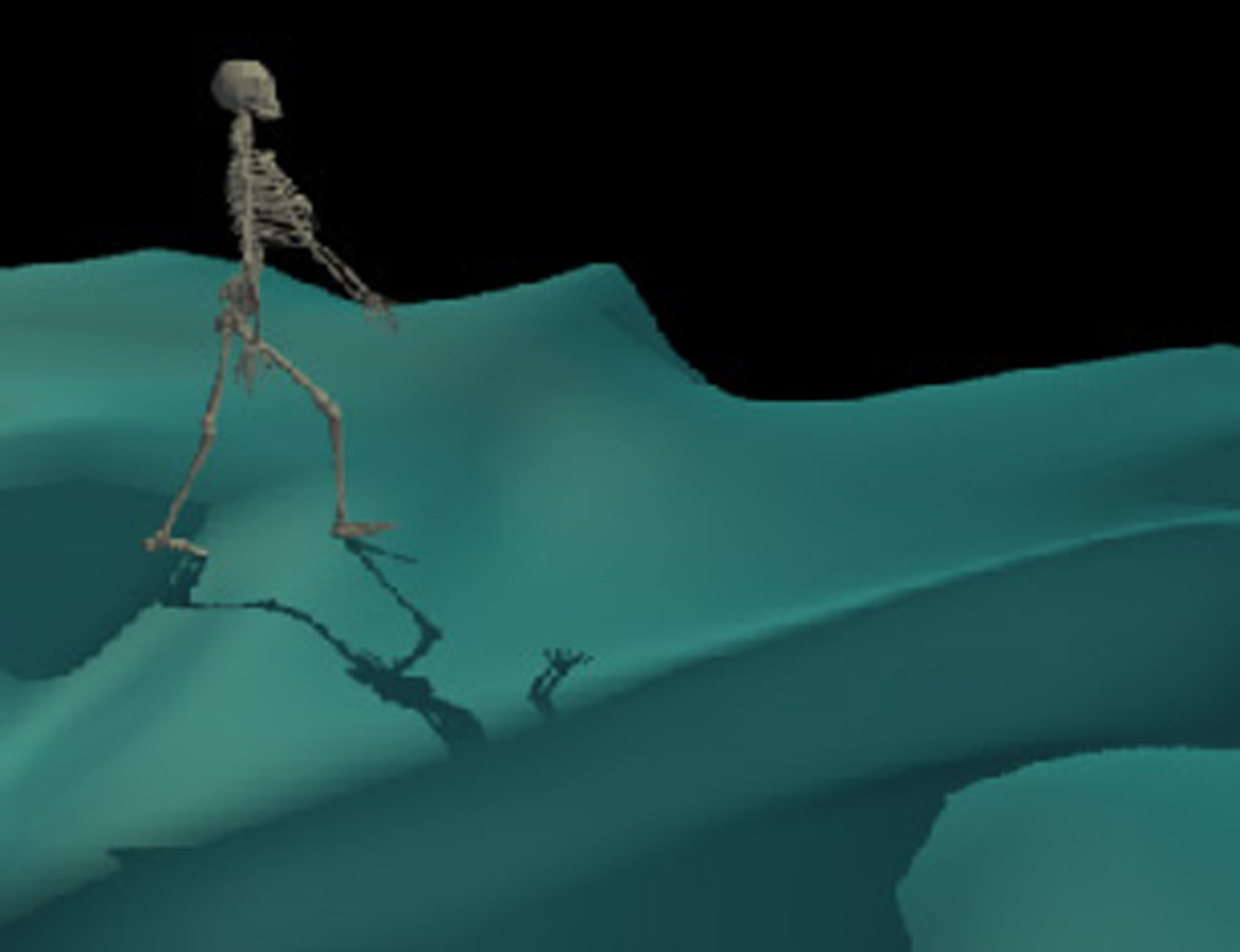“Automating gait generation” by Sun and Metaxas
Conference:
Type(s):
Title:
- Automating gait generation
Presenter(s)/Author(s):
Abstract:
One of the most routine actions humans perform is walking. To date, however, an automated tool for generating human gait is not available. This paper addresses the gait generation problem through three modular components. We present ElevWalker, a new low-level gait generator based on sagittal elevation angles, which allows curved locomotion – walking along a curved path – to be created easily; ElevInterp, which uses a new inverse motion interpolation algorithm to handle uneven terrain locomotion; and MetaGait, a high-level control module which allows an animator to control a figure’s walking simply by specifying a path. The synthesis of these components is an easy-to-use, real-time, fully automated animation tool suitable for off-line animation, virtual environments and simulation.
References:
1. F. Anderson and M. Pandy. A Dynamic Optimization Solution for One Complete Cycle of Human Gait. In Proc. International Society of Biomechanics XVII Congress, page 381, Calgary, Canada, 1999.
2. A. Borghese, L. Bianchi, and F. Lacquaniti. Kinematic Determinants of Human Locomotion. J. Physiology, (494):863-879, 1996.
3. R. Boulic, N. Thalmann, and D. Thalmann. A Global Human Walking Model with Real-time Kinematic Personification. The Visual Computer, (6):344-358, 1990.
4. A. Bruderlin and T. Calvert. Goal-directed, Dynamic Animation of Human Walking. In Computer Graphics (SIGGRAPH 89 Conference Proceedings), pages 233-242, 1989.
5. A. Bruderlin and T. Calvert. Interactive Animation of Personalized Human Locomotion. In Proc. of Graphics Interface 93, pages 17-23, 1993.
6. M. de Berg, M. van Kreveld, M. Overmars, and O. Schwarzkopf. Computational Geometry Algorithms and Applications. Springer- Verlag Berlin, 1997.
7. M. Girard and A. Maciejewski. Computational Modeling for the Computer Animation of Legged Figures. In Computer Graphics (SIG- GRAPH 85 Conference Proceedings), pages 263-270, 1985.
8. M. Gleicher. Motion Editing with Spacetime Constraints. In SIG- GRAPH 97 Conference Proceedings, pages 139-148, 1997.
9. R. Grasso, L. Bianchi, and F. Lacquaniti. Motor Patterns for Human Gait: Backward versus Forward Locomotion. J. Neurophysiology, 80:1868-1885, 1998.
10. J. Hodgins, W. Wooten, D. Brogan, and J. O’Brien. Animating Human Athletics. In SIGGRAPH 95 Conference Proceedings, pages 71-78, 1995.
11. T. Hudson, M. Lin, J. Cohen, S. Gottschalk, and D. Manocha. V-COLLIDE: Accelerated Collision Detection for VRML. In Proc. of VRML ’97, 1997.
12. V. Inman, H. Ralston, and F. Todd. Human Walking. Williams and Wilkins, Baltimore/London, 1981.
13. Y-M. Kang, H-G. Cho, and E-T. Lee. An Efficient Control over Human Running Animation with Extension of Planar Hopper Model. Journal of Visualization and Computer Animation, 10:215-224, 1999.
14. H. Ko. Kinematic and Dynamic Techniques for Analyzing, Predicting and Animating Human Locomotion. PhD thesis, Dept. CIS, University of Pennsylvania, 1984. MS-CIS-94-31.
15. H. Ko and N. Badler. Animating Human Locomotion in Real-time using Inverse Dynamics, Balance and Comfort Control. IEEE Computer Graphics and Applications, 16(2):50-59, March 1996.
16. H. Ko and J. Cremer. VRLOCO: Real-time Human Locomotion from Positional Input Streams. Presence, 5(4):367-380, 1996.
17. J. Laszlo, M. van de Panne, and E. Fiume. Limit Cycle Control and Its Application to the Animation of Balancing and Walking. In SIG- GRAPH 96 Conference Proceedings, pages 155-162, 1996.
18. J. Lee and S.-Y. Shin. A Hierarchical Approach to Interactive Motion Editing for Human-like Figures. In SIGGRAPH 99 Conference Proceedings, pages 39-47, 1999.
19. M. McKenna and D. Zeltzer. Dynamic Simulation of Autonomous Legged Locomotion. In Computer Graphics (SIGGRAPH 90 Conference Proceedings), pages 29-38, 1990.
20. F. Multon, L. France, M-P. Cani-Gascuel, and G. Debunne. Computer Animation of Human Walking: a Survey. Journal of Visualization and Computer Animation, 10:39-54, 1999.
21. M. Raibert and J. Hodgins. Animation of Dynamic Legged Locomotion. In Computer Graphics (SIGGRAPH 91 Conference Proceedings), pages 349-358, 1991.
22. C. Rose, M. Cohen, and B. Bodenheimer. Verbs and Adverbs: Multidimensional Motion Interpolation. IEEE Computer Graphics and Applications, 18(5):32-40, 1998.
23. H. Sun. Curved Path Human Locomotion on Uneven Terrain.PhD thesis, Dept. of Computer and Information Sciences, University of Pennsylvania, December 2000.
24. H. Sun, A. Goswami, D. Metaxas, and J. Bruckner. Cyclogram planarity is preserved in upward slope walking. In Proc. International Society of Biomechanics XVII Congress, page 514, Calgary, Canada, 1999.
25. H. Sun and D. Metaxas. Animation of Human Locomotion Using Sagittal Elevation Angles. Proceedings of Pacific Graphics 2000, 2000.
26. J. Sun, M. Walters, N. Svensson, and D. Lloyd. The Influence of Surface Slope on Human Gait Characteristics: a Study of Urban Pedestrians Walking on an Inclined Surface. Ergonomics, 39(4):677-692, 1996.
27. K. Tsutsuguchi, S. Shimada, Y. Suenaga, N. Sonehara, and S. Ohtsuka. Human Walking Animation Based on Foot Reaction Force in the Three-dimensional Virtual World. J. Visualization and Computer Animation, 11(1):3-16, 2000.
28. D. Wiley and J. Hahn. Interpolation Synthesis of Articulated Figure Motion. IEEE Computer Graphics and Applications, 17(6):39-45, 1997.
29. D. Zeltzer. Motor Control Techniques for Figure Animation. IEEE Computer Graphics and Applications, 2(9):53-59, 1982.




